Councillors must obtain a better understanding of how local authority assets are managed including risk tolerance, according to Ed Hammond who argues it could help improve cabinet decision making.

Managing councils’ financial assets could not be much more fraught at the moment, and the implications for local areas could not be much more high profile and political.
The realities of the situation are driving councils to make decisions about local services which are likely to have impact ten or twenty years from now, and which in many cases are effectively irrevocable.
This all has a profound impact on the way that councils manage their assets. Whatever a council’s reserves level might be, it will be coming under pressure at the moment — and this pressure is unlikely to let up any time soon.
This much we all know. The pressures that this places on cabinets are also well-understood. Finance cabinet members and leaders will spend time with the s151 officer going through the issues and the options and (hopefully) making tough decisions.
Member corps
The impact and influence of the wider member corps on this issue is, however, less well discussed. We at CfPS (centre for Public Scrutiny) have recently produced a guide to the scrutiny of treasury management called Treasure your assets, supported by the people at RP Martin and Camdor Global. We wanted to take the opportunity to assist non-executive members in playing a central role in constructively challenging councils’ approach to treasury management.
We think that non-executive members can and must play an active role. Councillors must get a better understanding of how councils’ assets are made to work for local people; this involves their getting a better understanding of the constraints (low interest rates and consequent low yields, amongst others) under which councils work.
Audit provides a mechanism for this check and balance, but scrutiny affords a broader chance for councillors not directly involved in decision-making to feed in. This allows for a wider range of perspectives and insights to be discussed — and for more general challenge to be exerted, in public.
What is the rationale for certain investments being made over others? Who has advised us on those matters, and using what criteria? What level of risk does the council feel is appropriate for us to take when investing, and why?
These are all questions that finance professionals will know the answers to, but bringing members into the discussion and helping them to understand the challenges can throw new light in a way that might make professionals look at them in a different way.
Risk and politics
The council’s approach to risk is a classic example of this. Risk tolerance and appetite is an intensely political decision. It is informed by evidence, but is ultimately subjective in nature. Cabinet will have its own conscious and defensible approach to risk – at least, it should do.
Getting a range of other members to discuss where risks lie on assets, the authority’s tolerance for those risks and effective mitigations can provoke a council’s leadership to refine its approach. Justifying these nuanced decisions in a public forum can act as a check on our assumptions — particularly useful in what can be a volatile investment market, where risk and reward are ever-changing.
We know that councils ought to be consistent in their application of risk. Some are taking very long-term decisions, for example, by locking up funds in commercial property.
Members looking at these decisions would therefore expect treasury management strategies to reflect a level of tolerance that justifies these decisions. In particular, members should expect that any limits applied to different asset classes ought to reflect the risks associated to those differing investments (so an asset backed bond investment for three years has a different risk profile to a three year investment in a building society or bank).
We want councillors to understand that treasury management is something they have to take seriously as part of their scrutiny role — our guide is about attempting to demystify a subject which councillors may feel is dry, or disconnected from the concerns of their residents.
But enthusing councillors about the possibilities of treasury management scrutiny can only take matters so far — to work properly, it also requires the commitment of finance professionals. It may be time for you to experiment with more sustained member involvement in these matters, and we hope that you agree with us, that it has the potential to sharpen up both the decisions you make, and your recommendations to cabinet.
Ed Hammond is director for local accountability at the Centre for Public Scrutiny.
The Centre for Public Scrutiny’s (CfPS) works to improve lives and places through effective governance and public scrutiny. The guide “Treasure your assets” is available to download on the CfPS website: www.cfps.org.uk














